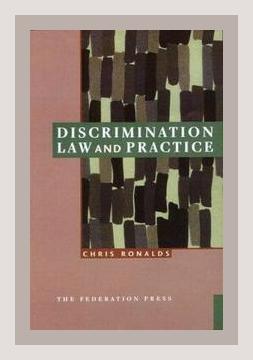Business Law and EthicsEmployment Law
“Discrimination Law and Practice” by Chris Ronalds is an insightful guide on navigating the complexities of employment discrimination law in Australia. The 2016 edition of the book offers a detailed analysis of various forms of discrimination and provides practical advice for both employers and employees. By breaking down the legislative framework and offering real-world examples, Ronalds equips readers with the tools to recognize, prevent, and address discrimination in the workplace. Below is a structured summary of the key points from the book along with actionable advice for readers.
Introduction to Discrimination Law in Australia
Key Point:
Understanding the legal framework governing discrimination is crucial for both preventing and addressing discriminatory practices in the workplace.
Actionable Advice:
– Legal Familiarization: Employers and employees should familiarize themselves with statutes such as the Australian Human Rights Commission Act 1986, the Sex Discrimination Act 1984, and the Disability Discrimination Act 1992.
Types of Discrimination
Key Point:
Discrimination can take various forms including direct discrimination, indirect discrimination, harassment, and victimization.
Direct Discrimination:
Occurs when an individual is treated less favorably than another person in a similar situation because of a particular characteristic.
Example:
A qualified woman being passed over for a promotion in favor of a less-qualified man due to gender bias.
Actionable Advice:
– Policy Development: Implement clear anti-discrimination policies that define direct discrimination and provide examples.
Indirect Discrimination:
Happens when a seemingly neutral policy or practice disproportionately affects individuals with a particular characteristic, and it is not reasonable in the circumstances.
Example:
A requirement for all employees to work on weekends may disadvantage employees who observe religious practices on those days.
Actionable Advice:
– Policy Review: Regularly review workplace policies to ensure they do not unintentionally disadvantage certain groups of employees.
Harassment:
Unwanted behavior related to a protected characteristic that creates a hostile, degrading, or offensive environment.
Example:
Sexual harassment in the form of inappropriate comments or unwelcome advances at work.
Actionable Advice:
– Training Programs: Conduct regular training sessions on harassment prevention and create a safe environment for reporting incidents.
Victimization:
Unfavorable treatment of someone because they have made, or intend to make, a discrimination complaint.
Example:
An employee being demoted after filing a complaint about racial discrimination.
Actionable Advice:
– Whistleblower Protections: Establish and enforce policies that protect employees from retaliation and ensure complaints are taken seriously.
Legal Protections and Remedies
Key Point:
There are various legal mechanisms and remedies available to victims of discrimination including internal grievance procedures, legal complaints, and court action.
Actionable Advice:
– Grievance Mechanisms: Set up clear and confidential internal grievance procedures to handle discrimination complaints effectively.
Case Studies
Key Point:
The book includes various case studies to illustrate how discrimination cases are handled and the outcomes of such cases.
Example:
A landmark case where an employee with a disability successfully claimed discrimination after being denied reasonable adjustments that would enable them to perform their job.
Actionable Advice:
– Reasonable Adjustments: Proactively make reasonable adjustments for employees with disabilities and assess each request on a case-by-case basis.
The Role of Human Resources
Key Point:
Human Resources (HR) plays a pivotal role in implementing anti-discrimination policies and fostering an inclusive work environment.
Actionable Advice:
– HR Training: Equip HR professionals with comprehensive training on discrimination law and effective resolution strategies.
Cultural Competency
Key Point:
Promoting cultural competence in the workplace helps prevent discrimination and fosters inclusion.
Example:
Cultural awareness programs helping to reduce biases and promote understanding between employees from diverse backgrounds.
Actionable Advice:
– Cultural Training: Introduce cultural competency training sessions to educate employees on diversity and inclusion.
Monitoring and Compliance
Key Point:
Regular monitoring and compliance checks are essential to ensure that anti-discrimination policies are being followed and effective.
Actionable Advice:
– Regular Audits: Conduct regular audits to assess the effectiveness of anti-discrimination measures and identify areas for improvement.
Legal Enforcement
Key Point:
Enforcement mechanisms, such as lodging complaints with the Fair Work Commission or the Australian Human Rights Commission, are available for addressing discrimination.
Actionable Advice:
– Legal Assistance: Encourage employees to seek legal advice or assistance if they believe they have been discriminated against.
Examples of Legal Outcomes
Key Point:
The book provides numerous examples of legal outcomes where courts have enforced anti-discrimination laws and provided remedies.
Example:
A case where an employer had to pay significant damages for failing to act on repeated complaints of workplace bullying.
Actionable Advice:
– Documentation: Keep detailed records of complaints and actions taken to ensure accountability and transparency.
Case Law Developments
Key Point:
The evolution of case law is crucial for adapting workplace practices to meet current legal standards.
Actionable Advice:
– Legal Updates: Stay informed about recent case law developments and adjust workplace policies accordingly.
Preventative Measures
Key Point:
Preventing discrimination is more effective and less costly than addressing it after it occurs.
Actionable Advice:
– Proactive Measures: Promote a positive and inclusive workplace culture through proactive measures such as diversity training and employee resource groups.
Conclusion and Future Directions
Key Point:
The landscape of discrimination law is continuously evolving, and both employers and employees must stay vigilant.
Actionable Advice:
– Ongoing Education: Regularly update training programs and policies to reflect new legal standards and best practices.
In summary, “Discrimination Law and Practice” by Chris Ronalds offers a comprehensive overview of the legal frameworks and practical strategies to combat discrimination in the workplace. By understanding the various forms of discrimination, implementing robust policies, and promoting an inclusive culture, employers and employees can work together to build a more equitable and respectful work environment.
